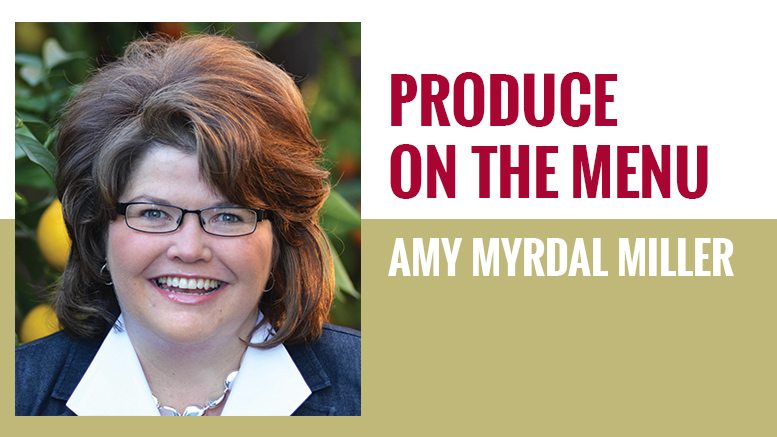Challenges Of Using Produce In Volume Foodservice
August 27, 2019 | 3 min to read
Large-volume foodservice operators face several challenges when increasing produce use on menus, categorized into seven key areas: seasonality, distribution and supply, format, consumer-driven demand, labor and process intensity, and communication. These issues affect sourcing, produce quality, consumer perceptions, labor costs, and marketing efforts. Amy Myrdal Miller emphasizes that produce professionals can alleviate challenges by providing insights, data, and solutions that align with current consumer trends and demands.

 When a large-volume foodservice operator wants to increase use of produce on menus, that leader must address a multitude of challenges. Recently, leaders from The Culinary Institute of America Health Menus R&D Collaborative worked to clearly define the challenges and group them into seven categories:
When a large-volume foodservice operator wants to increase use of produce on menus, that leader must address a multitude of challenges. Recently, leaders from The Culinary Institute of America Health Menus R&D Collaborative worked to clearly define the challenges and group them into seven categories:
- Seasonality. This challenge encompasses issues with domestic sourcing, shoulder seasons, produce quality, pricing fluctuations, regional production, regional volume, and four-season versus fixed menus. Chefs love using seasonal produce on menus, but not all operations can do this because of menu printing costs and other marketing and operational issues. Some use limited-time offers (LTOs) to menu seasonal produce items. Operations with four-season menus are typically focused on domestic or regional sourcing, while operations with fixed menus and occasional LTOs are more likely to be large chains with global sourcing.
- Distribution and Supply. This category includes issues like direct purchasing, availability, price, volume, quality, shelf life and food safety. A small regional operation or chain in the Northeast may be willing and able to buy local tomatoes in partnership with a local grower with third party food safety certification and a local distributor. However, a larger national chain could never risk having a single grower in a single region provide year-round supply to a nationwide network of restaurants.
- Format. This category includes issues related to perception as well as reality. The perception refers to the issue of which formats count in the eyes of their customers as well as nutrition and health influencers and leaders. If their customers think locally sourced, fresh produce is the only format that “counts,” then an operator who needs globally sourced fresh-cut produce may not get “credit” for that menu offering. This category also includes varietal availability, flavor (a critical issue for all chefs), shelf-life extensions in fresh packaging, the cook technique for individually quick frozen (IQF) or the preservation technique for high pressure processing (HPP), ethnic flavor extensions for IQF and value-added fresh cut. As I’ve written many times in this column, value-added produce is becoming more important in foodservice as minimal wage increases and skilled labor become harder to find.
- Consumer-Driven Demand. Who’s the biggest decision maker in any foodservice operation? It’s the consumer. This category includes issues related to consumer demands and perceptions, like flavor, familiarity, trends (e.g., what’s perceived as cool or desirable), perception of value (e.g., whole fruit versus fresh-cut fruit), health halos of certain products (e.g., kale), convenience and negative past experiences with produce in foodservice (for example, food poisoning attributed to produce).
- Labor and Process Intensive. This category includes issues such as:
- Labor costs (Is the higher price of a value-added product worth it given the labor costs involved in prep?)
- Skills training (Can I train employees how to cut avocados?), worker safety (Can I train employees how to cut avocados safely or will I face workers’ compensation issues?
- Familiarity with a product (Do the line cooks know how to cook this item so that it tastes great?)
- Negative past experiences (Do customers complain to front-of-house staff about how an item is presented or prepared?
- Storage (Does this item need special storage conditions?), equipment, cooking methods, shelf life and food safety.
- Communication. This final category includes issues such as:
- Nutrition information (Is all data that we need for menu claims available for this produce item?)
- Marketing (Are there other entities out there promoting this item that will enhance our marketing efforts)
- Social media (Are there social media campaigns or hashtags that we can use to our advantage?)
- In restaurant (How easy or difficult will it be to explain what this item is to guests?)
- Online (What information will we need to provide in online marketing to help our guests understand this item?).
Smart produce professionals can help alleviate some of the stress by providing data, insights or solutions. Do you have new technology that can help alleviate shelf life or food safety concerns? Is your company or another industry entity like a fruit or vegetable marketing order helping promote this produce item to consumers? Do you have consumer insights into how this produce item fits with current trends or consumer demand for produce items that offer certain nutrition or sensory benefits? The more you can help an operator see how your produce item solves problems, rather than creating challenges, the better off you and your sales will be.
Amy Myrdal Miller, MS, RDN, FAND is a farmer’s daughter from North Dakota, award-winning dietitian, culinary nutrition expert, and founder and president of Farmer’s Daughter Consulting, Inc. She is the director of The Culinary Institute of America Healthy Menus R&D Collaborative and a consultant for the Produce for Better Health Foundation. You can learn more about her business at www.farmersdaughterconsulting.com, and you can follow her insights on food and flavor on social media @AmyMyrdalMiller
13 of 15 article in Produce Business August 2019

